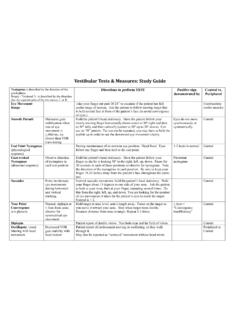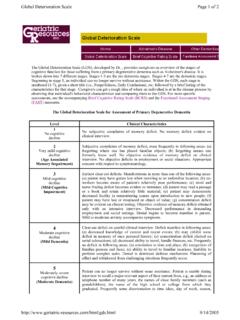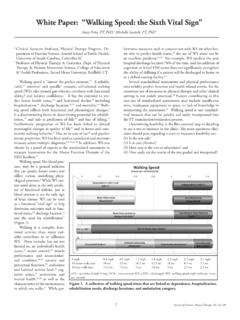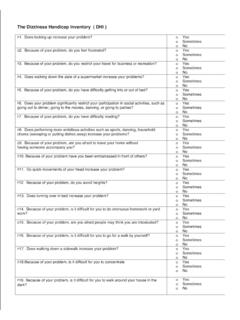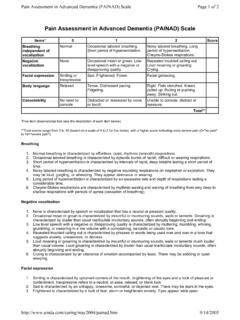Transcription of JPT3302 92-98 JGPT - University of Missouri
1 Research Report Responsiveness of the Physical Mobility Scale in Long-term Care Facility Residents Eric Pike, PT, DPT, MS, NFA1; Merrill R. Landers, PT, DPT, OCS2. ABSTRACT INTRODUCTION. Purpose: The Physical Mobility Scale (PMS) is used to evalu- One of the primary focuses of physical therapy in long-term ate the functional ability of aged adults. It has been shown to care is to improve the functional mobility of a resident. be reliable and has evidence to support its validity; however, Many times the resident is admitted at a very low function- there has been only 1 study performed to date that has addressed its responsiveness. The purpose of this study was al level, unable to complete the most basic tasks such as bed to evaluate the responsiveness of the PMS using residents of mobility and transfers. Because of these generalized deficits a long-term care facility.
2 In mobility, it is difficult to objectively measure functional Methods: Seventy participants who were permanent residents mobility and to identify improvement with treatment of a long-term care facility were recruited for this study. To because many of the current functional scales are not determine minimal detectable changes at the 95% confidence designed for use with residents of long-term care. level (MDC95), each participant was assessed using the PMS. on 2 occasions. To determine the clinically important differ- Functional scales that are typically used for residents of ence, participants were also tested on 2 separate occasions long-term care can be categorized by method of adminis- 3 months apart. The treating physical therapist then used a tration as a self-report instrument completed by the patient 7-point Likert scale to rate the participants' change in function.
3 Or as a performance-based measure requiring observation Results: Intrarater reliability for the pre- and post-PMS scores and rating of movement by a physical therapist or other for all 70 participants was excellent (intraclass correlational health care professional. For example, self-report question- coefficients [3,1] ). At the individual level, the MDC95. naires that address mobility include the California was points. At the group level, the MDC95 for the 70 par- ticipants was points. Minimal clinically important differ- Functional Evaluation instrument,1 the Movement Ability ence results suggest that a positive change of 5 points is measure ,2,3 the Health Assessment Questionnaire,4,5 and improved clinically whereas a 4-point decrease in score is the Functional Status Although these ques- considered worsened clinically. tionnaires are easy to administer and appear to adequately Conclusions: The psychometric properties of the PMS in an address mobility, they are inherently subject to response aging adult population of long-term residents are excellent, bias.
4 In addition, self-report questionnaires can be prob- demonstrating good reliability and responsiveness. These lematic in patient populations with a high incidence of cog- results also offer some support to the validity of the PMS in this patient population. The utility of the PMS in the long-term nitive impairment, as is commonly found in long-term care care setting for assessing patient status and positive and/or facilities. Sinoff and Ore7 report that self-report question- negative functional outcomes is of value to both researcher naires are problematic when used with persons older than and clinician. 75 years. They found inconsistency between self-report and Key Words: mobility, psychometrics, reliability, reproducibility, actual performance of questionnaire tasks, suggesting that transfers older adults may not accurately perceive their physical func- (J Geriatr Phys Ther 2010;33: 92-98 .)
5 Tion. Brach et al8 suggest that instruments based on per- formance are more likely to identify deficits in physical function than questionnaires that are based on self-report. Performance-based scales can be subclassified into those that test mobility skills alone (eg, Rivermead Mobility Index9 and Clinical Outcome Variables Scale10) or mobility and activities of daily living (eg, Edmonton Functional Assessment Tool,11-13 Barthel Index,14 Katz Index of Independence in Activities of Daily Living,15 and the 1 Nevada State Veterans' Home, Boulder City. Functional Independence Measure16) or are disease-specific 2 Department of Physical Therapy, School of Allied Health in looking at functional mobility (eg, Motor Assessment Sciences, University of Nevada, Las Vegas. Scale for persons with stroke17 and the Parkinson Activity Address correspondence to: Eric Pike, PT, DPT, MS, NFA, Scale18).
6 Other scales test specific aspects of mobility, such Nevada State Veterans' Home, 100 Veteran's Memorial Dr, as balance and gait (eg, Berg Balance Scale19 and Boulder City, NV 89005 Performance Oriented Mobility Assessment20). Many of 92 Volume 33 Number 2 April-June 2010. Research Report these performance-based scales include items that are unre- veterans nursing facility. The most common diagnoses lated to mobility (eg, continence or communication), items included hypertension ( ), dementia ( ), chronic that would be inappropriate for the majority of long-term obstructive pulmonary disease ( ), diabetes mellitus care facility residents (eg, running), or items specific to a dis- ( ), coronary artery disease ( ), and cerebrovas- ease process (eg, hand movements or gait akinesia). Because cular accident ( ). Initial recruitment consisted of a of this, many are not appropriate for the general long-term verbal invitation to participate from the lead author to res- care facility population.
7 In their place, physical therapists idents. Inclusion criteria were (1) ability to follow verbal may use subjective ratings to evaluate the resident's func- instructions and (2) no medical contraindications to per- tional ability. Although these subjective ratings are usually forming basic mobility tasks. Those who did not meet the performance-based, they are not standardized and may inclusion criteria were excluded from the study. All partici- reflect unwanted bias or excessive error in the rating. pants provided informed consent under the University of Nitz and Hourigan21 and Barker et al22 reported on a Nevada, Las Vegas institutional review board approval scale, the Physical Mobility Scale (PMS), that was developed prior to participation in the study. by physical therapists and seems to be an appropriate tool to evaluate the functional mobility of aging adults in long-term Procedure and Data Collection care.
8 Nitz and Hourigan21 found the PMS to have good reli- To determine the responsiveness of the PMS, participants ability in participants ranging in age from 35 to 90 years. were assessed by the same physical therapist on 2 separate Interrater reliability using intraclass correlational coefficients occasions. The PMS includes measures of 9 basic move- (ICC) for individual items ranged from to and was ments, including supine to side-lying, supine to sitting, sit- not affected by the physical therapists' level of experience. ting balance, sitting to and from standing, standing balance, Intrarater reliability was also established with an ICC level transferring, and ambulating (Appendix).21 Each of the 9. of more than The PMS demonstrated concurrent valid- measures is scored on a scale of 0 to 5, with 0 being depend- ity (Spearman's rank order agreement to ) with ent and 5 independent.
9 Total scores range from 0 to 45, the performance scoring outcomes of the Clinical Outcomes with 45 indicating independent mobility functioning and 0. Variable Scale and the Rivermead Mobility Index. Barker indicating very low mobility functioning. et al22 also reported good interrater reliability ( .60 for The original PMS does not have formal instructions most items) and evidence to support construct validity. on how to implement the test or definitions of the items. While the PMS seems to have good reliability and good No specific instructions in the original PMS regarding support for validity for use with adults, the responsiveness single limb balance time and wheelchair mobility dis- of this performance-based scale has been reported in only 1 tance were provided in either article on the ,22 In Responsiveness allows the clinician to make deci- this study, some clarifications were made to ensure con- sions about a change in a patient's outcome as detected by sistency and instructions were added to the scoring the scale.
10 In addition, it allows for inference about the effec- sheet. The clarifications that were made are italicized in tiveness of treatment, economic appraisals, and other pro- the Appendix. The first 5 items and the item on transfers are gram Two types of responsiveness have been well described in the scoring sheet and are self-explanatory. commonly used in the physical therapy literature, minimal The standing balance item was clarified to state that the detectable change (MDC) and minimal clinically important single limb balance must be maintained for 10 seconds difference (MCID). Barker et al22 determined the MDC of to receive a score of 5. This follows the same guidelines the PMS to be at the 90% confidence level. To our as the Berg Balance Scale,19 in which the participant knowledge, no study has reported the MCID of the PMS. must maintain a single leg stand for 10 seconds to The MDC is the minimal amount of change required to receive full marks for that item.
